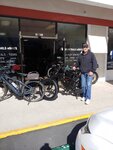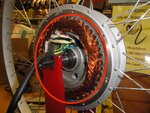Here is a good video to get yourself up to speed in the basics of understanding how voltage affects speed. This applies to hub drive motors.
Micah is a degreed mechanical engineer (as I am) so he has a firm grasp on the fundamentals and can explain it well.
When you get into mid drives like Bosch or Brose or Yamaha, due to their design choices on the type of motor they are using, the gear ratios, the higher speeds they are choosing to run their motors at, and the limitations of how much torque they are willing to transmit through the crank, and then chain, back to the cassette, it's not prudent to go from 36 volts to a higher voltage to try to get higher speed. They are really constrained in what they can do with the mid drive, and how much total wattage and current they can apply to an already super high rpm motor, without making significant other compromises in terms of stress on the internal motor gears, heat build up, and durability.
With a hub drive I can overvolt that motor very easily as explained in Micahs video above. I can also optimize current flow, and have 750 watts to work with any way I chose. The same cannot be done with a brand name mid drive (Bosch, brose, Yamaha) which typically is only running 250 watts, with occasional peaks allowed of 500 watts, and doing so only at 36 volts, without risking substantial damage to that motor or its internal gearing. These guys are already running near the top of their build envelope, and putting much more than 80 nm of torque will simply rip the heck out of any chain drive or wear it out in no time.
Bafang has a completely different gearing set up for their mid drives than the big name guys, running their motors at lower RPMs, but also lower internal gear ratios, so they are not as efficient but their design allows them to use as high as 60 volts, and they are taking their motors as high as 1600 watts. Well again, that motor design rips drive trains to shreds even when you attempt to use a beefier chain , as the cassettes are limited in their thickness and strength, unless you convince those high volume guys like Shimano, Sunrace, etc to completely redesign their cassettes. They arent likely to do that anytime soon. I point this out about bafang, bc you aren't going to get much better acceleration out of a bafang unless you want to constantly be repairing your drive train.
The industry is already about 30 to 40 to 1, number of hub drive ebikes sold vs mid drives, in the US and Europe , and not including China usage since they are selling tens of millions more ebikes inside their own country with 95% of them hub drive so that would not be a fair comparison.
Over time you will see considerably more development and use of hub drives, as they start building more efficient hub drives, start going the direction of tesla with hub motors at each wheel, and they are much simpler to build, to repair, and far more durable than any mid drive design will ever be.
The hub drive industry has taken the very least path of resistance, not really needing much technology development since those motors have been around for eons and are dirt cheap and built in much higher volumes and for many more applications outside of ebikes. We will start seeing a LOT more advancements in hub drives in the next few years, while mid drives will top out due to their high cost to manufacture, very high complexity, low build volume, and far too much unnecessary expense for entire frame redesigns.

www.juicedbikes.com



